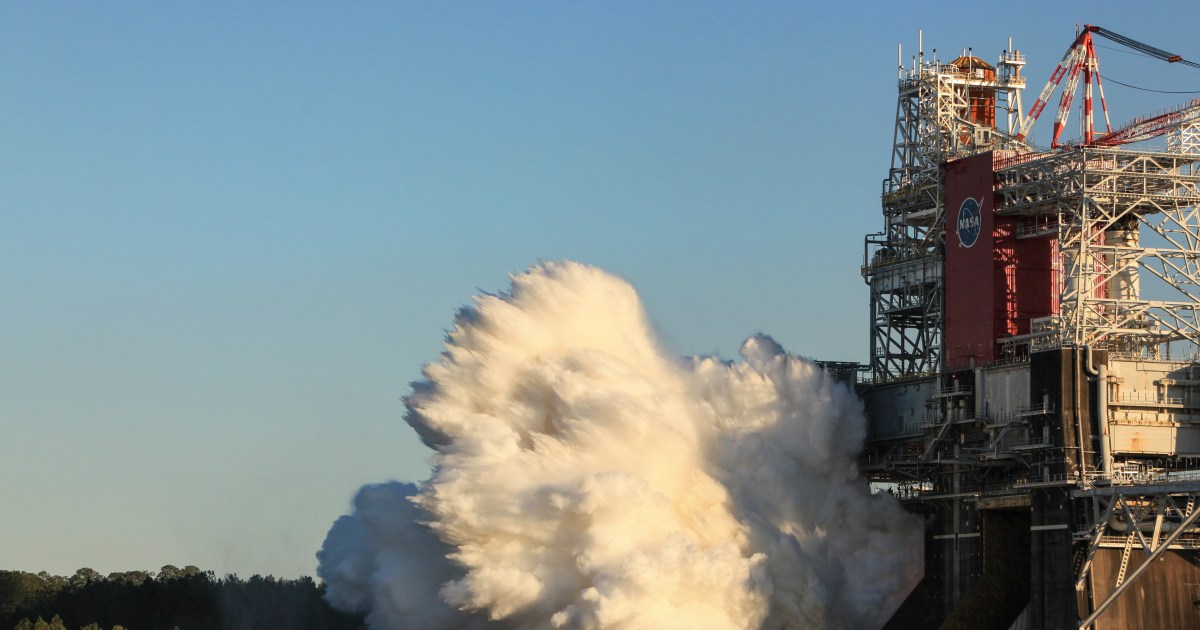
US space agency NASA ignited all four engines of its giant Space Launch System (SLS) for the first time on Saturday, but the “hot fire” test ended much earlier than expected.
Mounted in a test facility at NASA’s Stennis Space Center in the state of Mississippi, the SLS’s 65-metre-tall (212-foot) core stage roared to life at 4:27pm local time (22:27 GMT) and burned for more than a minute before the exercise was aborted.
The test was supposed to last for eight minutes to simulate the rocket’s climb to orbit.
NASA said in a statement that its teams were “assessing the data to determine what caused the early shutdown”.
Watch all four @NASA_SLS core stage engines roar to life and shake the ground in Mississippi.
Teams are assessing the data on early engine shutdown. pic.twitter.com/U5bNqqbdZd
— NASA (@NASA) January 16, 2021
Completely concur. Very valuable. Now the discussions will begin as to whether there was enough data collected or if the test needs to be rerun – either way that engine will likely be changed out. Of course the experts will probably tell us at the post test conference shortly https://t.co/523kXgoVl5
— Wayne Hale (@waynehale) January 16, 2021
The fiery show on Saturday is a vital step for the space agency and its top SLS contractor, Boeing, before the SLS’s planned debut launch later this year.
The success of that unmanned mission, called “Artemis I”, will set the stage for the first landing on the Moon by humans since the Apollo 17 mission in 1972. US President Donald Trump has pushed for that trip – which will also see the first woman on the Moon – to take place by 2024.
‘Important milestone’
It was unclear whether Boeing and NASA would have to repeat Saturday’s test, a prospect that could push the SLS’s debut launch into 2022.
Speaking to reporters following the test, SLS Program Manager John Honeycut said it was hard to detect what exactly went wrong. He said they had seen a flash in a thermal protection blanket on one of the engines and were analysing the data.
And despite the test being cut short, NASA Administrator Jim Bridenstine said the firing of the RS-25 engines had provided valuable information for the planned missions.
“I know not everybody is feeling as happy as we otherwise could because we wanted to get eight minutes of a hot fire and we got over a minute, but I just want to remind people where we’ve been and where we’re going and what an important milestone this is,” he told reporters.
"Now we've got to go figure out what made it make that decision, make some adjustments, and fix it."
For more information about the Green Run test series, visit: https://t.co/EDohQQY4I1
— NASA (@NASA) January 17, 2021
He added: “We got lots of data that we’re going to be able to sort through,” to determine if a do-over is needed and whether a November 2021 debut launch date is still possible.
In addition to Artemis I, two other missions are planned. The first mission will test the SLS and an unmanned Orion spacecraft, while Artemis II will take astronauts around the Moon in 2023 but it will not land. Astronauts will only be sent to the Moon during the third mission in 2024.
The SLS, in its configuration for Artemis I, will stand 98 metres (322 feet), taller than the Statue of Liberty, and is more powerful than the Saturn V rockets used in the Apollo missions.
The rocket is now three years behind schedule and nearly $3bn over budget.
Critics have long argued for NASA to retire the rocket’s shuttle-era core technologies, which have launch costs of $1bn or more per mission, in favour of newer commercial alternatives that promise lower costs.
By comparison, it costs as little as $90m to fly the massive, but less powerful, Falcon Heavy rocket designed and manufactured by Elon Musk’s SpaceX, and some $350m per launch for United Launch Alliance’s legacy Delta IV Heavy.
While newer, more reusable rockets from both companies – SpaceX’s Starship and United Launch Alliance’s Vulcan – promise heavier lift capacity than the Falcon Heavy or Delta IV Heavy, potentially at a lower cost, SLS backers have argued it would take two or more launches on those rockets to launch what the SLS could carry in a single mission.
NASA’s eventual goal is to establish an Artemis Base Camp on the Moon before the end of the decade, an ambitious plan that would require tens of billions of dollars in funding and a green light from President-elect Joe Biden and Congress.
A manned return to the Moon is the first part of the Artemis programme to set up a long-term colony and test technologies for a crewed mission to Mars in the 2030s
https://news.google.com/__i/rss/rd/articles/CBMiXWh0dHBzOi8vd3d3LmFsamF6ZWVyYS5jb20vbmV3cy8yMDIxLzEvMTcvbmFzYS1jdXRzLXNob3J0LWdyb3VuZC10ZXN0LW9mLWl0cy1naWFudC1tb29uLXJvY2tldNIBYWh0dHBzOi8vd3d3LmFsamF6ZWVyYS5jb20vYW1wL25ld3MvMjAyMS8xLzE3L25hc2EtY3V0cy1zaG9ydC1ncm91bmQtdGVzdC1vZi1pdHMtZ2lhbnQtbW9vbi1yb2NrZXQ?oc=5
2021-01-17 09:33:45Z
52781302554625
Tidak ada komentar:
Posting Komentar